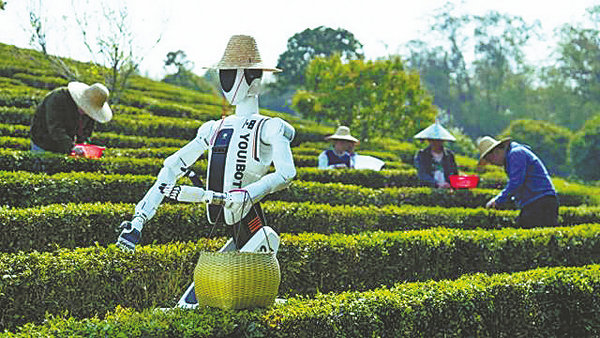Robotic revolution is brewing in China's traditional tea gardens


GUANGZHOU — In a lush tea garden in the southern Chinese city of Huizhou, Guangdong province, a humanoid robot named Xunxiao delicately plucks tender tea leaves alongside workers. With a bamboo basket on its left arm and its right hand moving with surprising precision, the machine accurately selects only the freshest buds.
This isn't a scene from a science fiction film. It's China's latest push to blend cutting-edge embodied artificial intelligence with its long-standing tea-picking tradition. The Chinese government has designated embodied intelligence as an industry of the future that it intends to cultivate.
Xunxiao, developed by the Youibot-XJTU embodied intelligence robot research institute, represents a new generation of versatile robots. It combines vision-language models with specialized expert systems to handle complex, unstructured tasks that traditional industrial robots cannot manage.
"Tasks requiring flexible operations in non-structured environments with long task chains are impossible for traditional industrial robots," explains Bian Xu, co-founder of Youibot, a firm based in Xi'an, the capital of northwestern China's Shaanxi province. The startup teamed with Xi'an Jiaotong University to develop the robot.
During tea-picking peak seasons, many gardens face a shortage of tea-pickers. Teapicking robots have emerged as a sought-after alternative solution.
Intelligent robots are sparking an agricultural revolution in China.
This development comes as China's humanoid robot industry gained momentum in 2024, with AI-powered robots increasingly being used in agricultural settings nationwide.
In the southern island province of Hainan, smart rubber-tapping robots are used to tackle labor shortages.
In a demonstration video, a self-navigating robot is seen approaching a rubber tree, halting with pinpoint accuracy before extending its robotic arm to execute a precise cutting motion on the trunk.
What makes Xunxiao particularly impressive is its navigation system. Using high-precision 3D fusion technology, it creates real-time three-dimensional maps of complex environments.
The robot can identify stairs, slopes and perforated surfaces while maintaining positioning accuracy within 0.5 centimeters — even in crowded spaces, according to Bian.
Notably, Xunxiao's capabilities have extended beyond tea gardens. It can inspect power equipment, perform semiconductor precision operations, and handle intelligent warehouse sorting, all without requiring hardware modifications when switching between tasks.
As these robots move from tea gardens to factory floors, they represent China's vision of integrating AI into traditional industries.
"AI is evolving from a tool into an innovation engine," says Huang Minlie, a computer scientist from Tsinghua University in Beijing.
The fusion of embodied intelligence, large models and robots is fueling applications like humanoid robots to become a key focus for industry development, Huang adds.
Xinhua




































